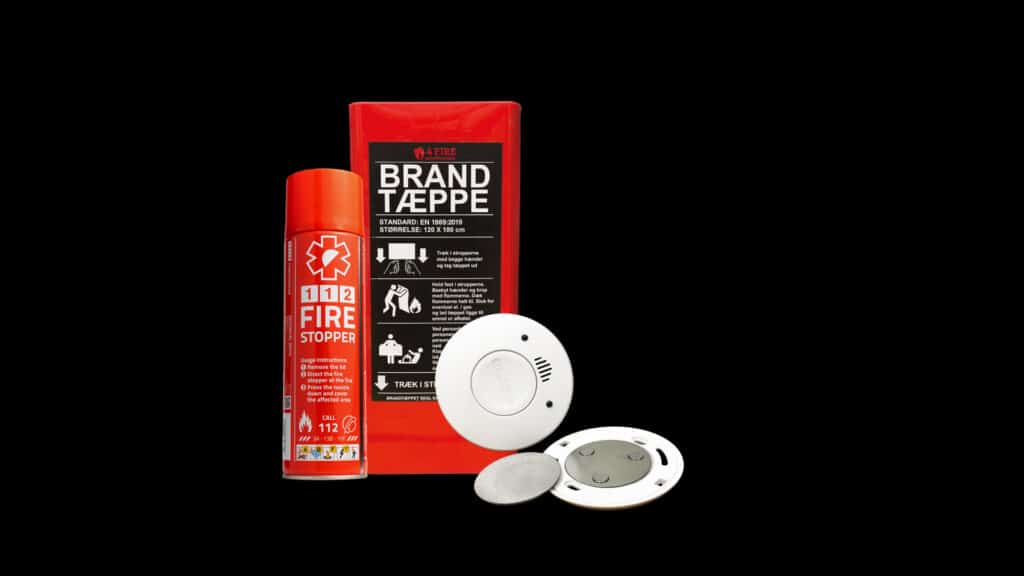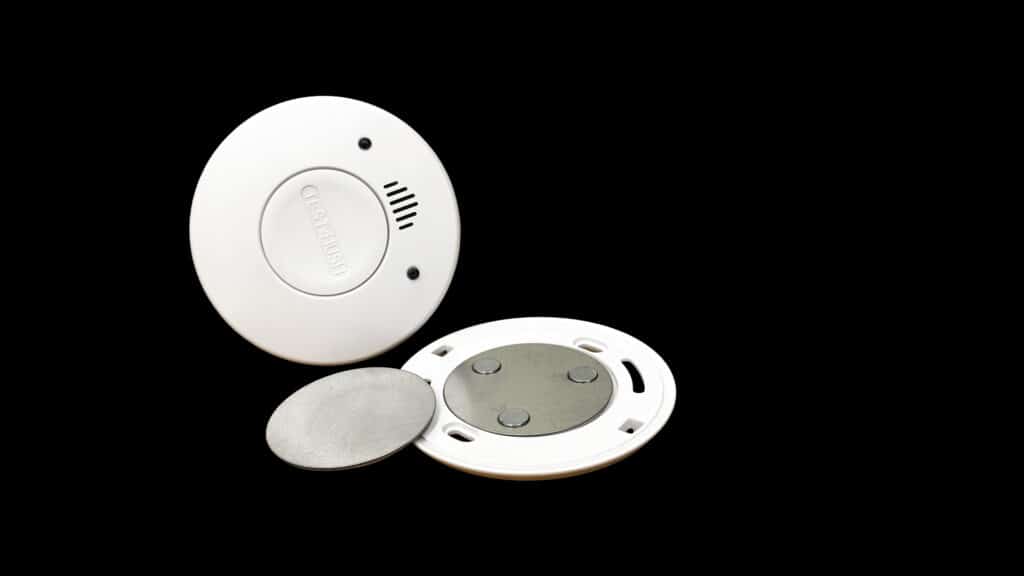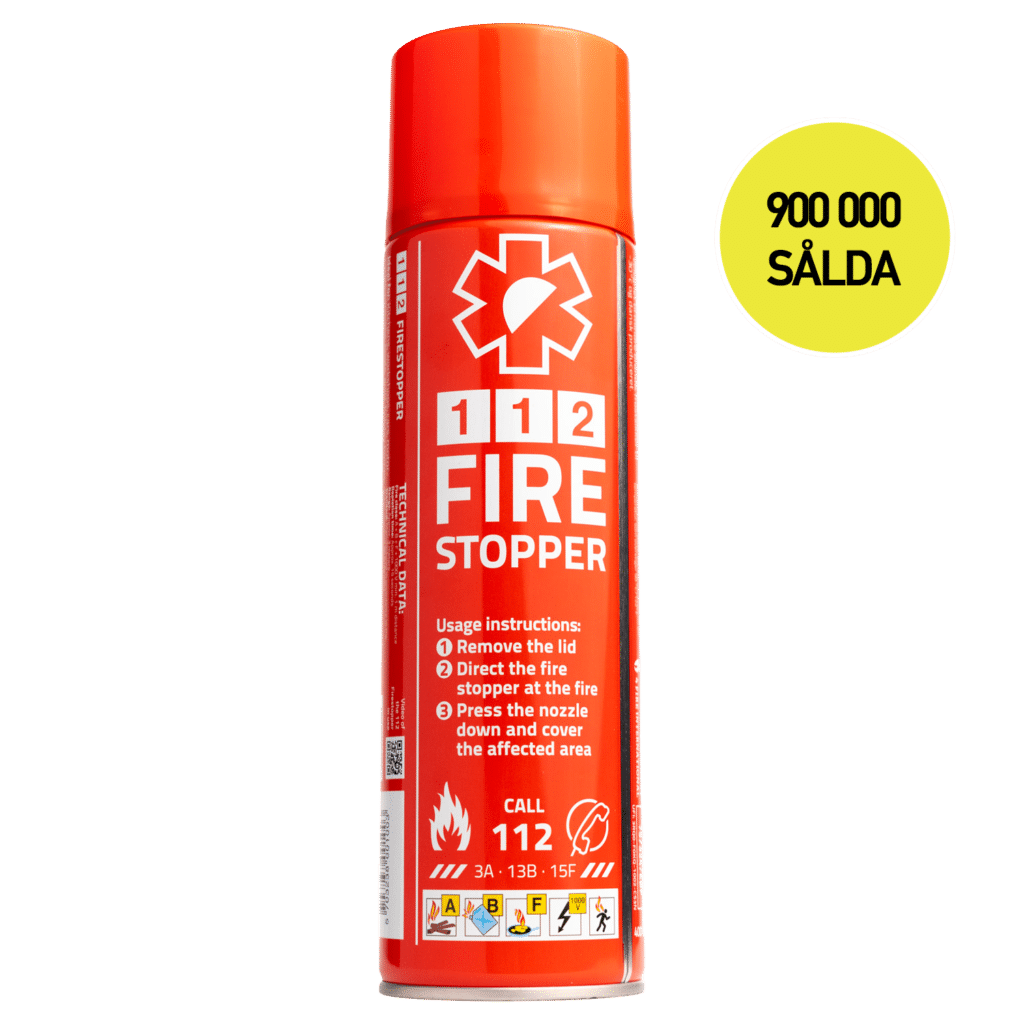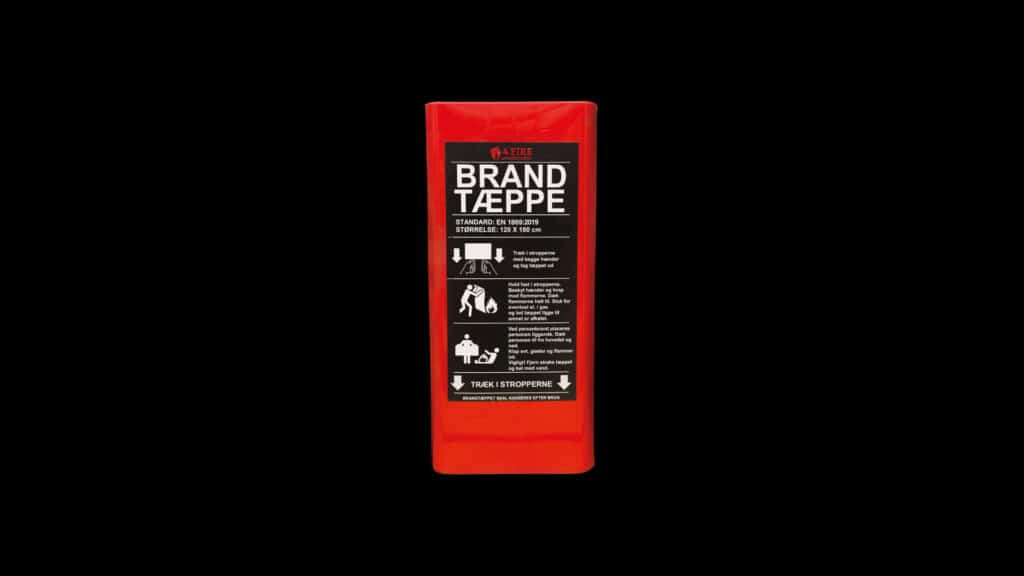
Protecting your home against fire is an investment in the safety and security of your whole family. It’s not just about preventing risks, but also about knowing what to do in case of an accident. Here we go through the key steps to fireproof your home.
Why is fire safety important?
Dwelling fires can occur due to a variety of causes, including electrical faults, cooking incidents and carelessness with candles. According to statistics from MSB, thousands of residential fires occur every year in Sweden. By taking preventive measures, you can reduce the risk of a fire occurring and improve your preparedness in case of an accident.
1.Installing smoke alarms – A life-saving measure
Smoke alarms are one of the most important investments you can make for your home and family. They are easy to install, affordable and can provide vital time to react in case of a fire. According to the Swedish Civil Contingencies Agency (MSB), smoke alarms significantly reduce the risk of serious injury by providing early warning of smoke development.
To ensure maximum safety, smoke alarms should be strategically placed:
- All bedrooms: To wake sleeping persons in case of fire.
- Kitchens and living rooms: Where the risk of fires is often higher due to cooking or electrical appliances.
- Hallways and corridors connecting bedrooms: To give the earliest possible warning of a fire spreading.
Smoke alarms should be tested monthly by pressing the test button. Change the batteries at least once a year, or choose a modern model with a 10-year battery to reduce the need for maintenance.
For easy installation and reliability, our 4fire Smoke Alarm offers an innovative bracket that allows you to place it anywhere without tools. It also has a long battery life of 10 years, making it a convenient and durable option.
Having working smoke alarms in the right place can be the difference between life and death. Protect your home and family by installing smoke alarms today. Explore our smoke alarms and make sure your home is prepared.

2. Invest in fire extinguishers
A good fire extinguisher can be crucial in a critical situation. A 6kg powder fire extinguisher is recommended for the home as they are effective against:
- Fires in solid materials such as wood and textiles.
- Fires in liquids such as oil and gasoline.
- Electrical fires.
A major disadvantage of a powder fire extinguisher is that the powder that remains after the fire is incredibly difficult to get rid of and it leads to large costs for insurance companies annually. The powder spreads quickly throughout the room and it will be very difficult to see anything while the fire is being extinguished, in small spaces.
How to clean up after a powder extinguisher
After using a powder extinguisher, it is important to carry out a thorough clean-up. Powder from fire extinguishers can cause damage to electronics, surfaces and air quality if not properly removed. Here is a detailed guide on how to proceed and what can happen if the clean-up is not carried out.
Step 1: Protect yourself
Powder from fire extinguishers can irritate skin, eyes and respiratory tract. Wear protective gloves, face mask and safety glasses.
Step 2: Collect tools
- Vacuum cleaner with HEPA filter (to avoid the powder being dispersed in the air).
- Damp cloth or mop.
- Mild detergent.
Step 3: Prepare the surface
Do not try to sweep the powder, as this may cause the particles to disperse into the air. First vacuum carefully with a vacuum cleaner equipped with a HEPA filter.
Step 4: Clean with moisture
Use a damp cloth or mop to wipe off the residue. Fire extinguisher powders are often based on ammonium phosphate or sodium bicarbonate, which can react with water, so clean gently and dry thoroughly afterwards.
Step 5: Check electronics
If powder has come into contact with electronics, it can cause corrosion. Let a professional service technician handle the cleaning of electronic equipment.
Step 6: Ventilate the space
Make sure to air the room properly to get rid of any powder particles that may have spread.
What happens if you don’t clean up?
If powder from a fire extinguisher is not cleaned up, it can lead to several problems:
- Corrosion: Ammonium phosphate in powder can cause corrosion of metal surfaces and electronics.
- Irritation: Powder particles in the air can irritate airways and cause allergic reactions.
- Damage to surfaces: Powder can stain or damage furniture and floors if not removed quickly.
- Functional problems: Electronic devices exposed to powder may stop working or short-circuit.
According to the Swedish Fire Protection Association, it is recommended that the decontamination of powder from fire extinguishers is carried out immediately to minimize damage and health risks. You can read more about their advice and guidelines on the Fire Protection Association website.
This is where a small fire extinguisher like the 112 model comes in as a smarter option.

Advantages of a small 112 fire extinguisher
- Easy and simple to use: A small 112 fire extinguisher is easy to handle, even for people with no previous experience. It reduces the risk of mistakes in a stressful situation
- . Minimal cleanup required: This type of extinguisher is designed to cause as little damage as possible to the surroundings. This means you don’t have to go through the extensive cleanup process that a powder extinguisher requires.
- Effective as a first response: The 112 fire extinguisher is ideal as a first response to small fires in the home, for example:
- – Grease fires in the kitchen.
- – Minor electrical fires.
- – Glowing materials such as fabric or paper.
- Easy to store: Thanks to its compact size, a 112 fire extinguisher can be easily placed in strategic locations such as the kitchen, bedroom or at the entrance without taking up too much space.
Economic and practical benefits
A major benefit of a 112 fire extinguisher is that it saves both time and money in the long run. As it requires minimal clean-up after use, you can avoid expensive repairs and replacement costs. Insurance companies estimate that many of their fire clean-up costs can be directly linked to the use of powder extinguishers.
Recommendation
Keep at least one 112 extinguisher in the kitchen and another at the main entrance, where it is easy to reach in case of fire. The advantages of the small extinguisher make it an excellent complement to a larger powder extinguisher that can be used for larger fires.
Read more and buy 112 fire extinguisher here to ensure you are ready to deal with fires in your home effectively and safely.Keep at least one fire extinguisher in the kitchen and another at the main entrance.
3. use fire blankets
Fire blankets are simple, effective and reliable tools to extinguish small fires and protect you during evacuation. They are particularly useful in the kitchen, where grease fires are one of the most common causes of fires. Grease fires cannot be extinguished with a powder extinguisher, and this can make the fire worse and spread further. In this case, a fire blanket is a safer option as it smothers the fire by blocking the oxygen supply.
Why are fire blankets important?
Fire blankets leave no residue or damage after use, making them particularly suitable in spaces where you want to avoid unnecessary cleanup. Not only are they effective against small kitchen fires, but they can also protect you in the event of an evacuation, as they can shield you from heat and flames if you hold it in front of you or place it over you.
Placement and completion with 112 fire extinguishers
For maximum protection in the kitchen, a combination of a fire blanket and a 112 extinguisher is recommended. Unlike powder extinguishers, which cannot be used against grease fires, the 112 fire extinguisher is designed to extinguish all types of fires, including:
- Grease fires
- Electrical fires.
- Fires in solids and liquids.
This makes it a perfect complement to a fire blanket, as it can be used both as a first response and to deal with larger fires if the situation escalates.
Place fire blankets strategically where the risks are greatest:
- In the kitchen: Near the stove for quick action in case of grease fires.
- For stoves and fireplaces: to deal with sparks or small fires.
- In the garage or workshop: to quickly smother small fires.
Educating the whole family
Make sure everyone in the household knows how to use both a fire blanket and a fire extinguisher. Practicing how to use these tools quickly and correctly can be crucial in an emergency.
Recommendation
A fire blanket and a 112 fire extinguisher together provide complete protection for the kitchen and other risk areas in the home. Read more and discover our recommended fire blankets and 112 fire extinguishers to create a safer home.

4. Create an evacuation plan
Having a clear and well-prepared evacuation plan is crucial to saving lives in the event of a fire. When a fire breaks out, stress and panic can make it difficult to act rationally, but with a well-prepared plan, everyone in the household knows exactly what to do. Here is a step-by-step guide on how to create an effective evacuation plan, based on recommendations from the Swedish Civil Contingencies Agency (MSB) and the the Fire Protection Association.
Step 1: Identify clear escape routes
Map all rooms in the home and ensure that there are at least two possible escape routes from each space, if possible. Doors and windows are the most common escape routes. Check that windows can be easily opened and that nothing is blocking the doors. For apartment buildings or multi-storey homes, a fire escape ladder can be a crucial investment to enable safe escape from the upper floor. The MSB recommends keeping escape routes clear at all times and testing them regularly.
Step 2: Decide on a meeting place outside the home
A common meeting point will help you quickly check that everyone in the household has made it out safely. This place should be far enough from the house to avoid danger but still easy to find, for example by a letterbox, a tree or a neighbor’s driveway.
Step 3: Procedures for children, elderly and pets
It is important to bear in mind that some members of the household may need extra help. Designate an adult to be responsible for small children, elderly people or people with disabilities. In the case of pets, their transport cages or leashes can be kept close to the escape routes to facilitate evacuation. According to the Fire Protection Association, planning in advance for these circumstances is crucial to avoid panic in a critical situation.
Step 4: Practice the plan regularly
An evacuation plan is only effective if everyone in the family knows how to follow it. MSB suggests conducting fire drills at least once a year. Simulate different scenarios, such as one of the primary escape routes being blocked, and practice finding alternative ways out quickly. By practicing regularly, the plan will become a natural part of your family’s safety thinking.
Bonus: Learn about fire safety
In addition to practicing the evacuation plan, it is important to educate the whole family about fire safety. Teach children never to hide in case of fire and explain the importance of staying low to the ground to avoid smoke. The Fire Protection Association offers resources and training that can help.
5. store hazardous materials safely
Storing matches, lighters and flammable liquids properly can prevent accidents. According to the MSB many fires are the result of negligence or improper handling of flammable materials.
Matches and lighters
Keep matches and lighters out of reach of children, preferably in lockable cabinets or high on a shelf. Teach children about the dangers of fire and explain why these items are not toys.
Flammable liquids
Chemicals such as gasoline, white spirit and solvents should always be stored in their original packaging in a cool, well-ventilated area, away from heat sources. Avoid storing large quantities of flammable liquids indoors. The Fire Protection Association recommends using approved safety containers for storage.
Clear procedures
Ensure that container lids are always tightly closed and that any leaks are cleaned up immediately. Clean the area and ventilate the space to minimize risks.
6. maintenance of electrical appliances
Electrical problems are one of the most common causes of residential fires. Regular maintenance of cables, sockets and appliances is essential to reduce the risk.
Inspecting cables and connectors
Check cables and connectors regularly for cracks, burn marks or loose connections. If you find any damage, replace them immediately. Never use an appliance with a damaged cable.
Avoid overloading electrical outlets
According to MSB, overloaded electrical outlets are a common cause of fire. Use power strips with built-in surge protection and distribute power-hungry appliances between several outlets.
Clean and maintain
Vacuum regularly behind and under heat-generating appliances such as radiators, refrigerators and televisions to avoid dust accumulation, which can overheat and cause fires.
Professional help
If you suspect problems with your electrical system, such as recurring fuse problems or strange noises from sockets, contact a qualified electrician. Never try to fix electrical faults yourself unless you have the right skills.
Creating a fire-safe home is about being prepared and being proactive. Combining preventive measures such as smoke alarms, fire extinguishers and fire blankets with a clear evacuation plan can protect both life and property. Regular training and equipment maintenance are key to acting quickly and correctly in the event of an accident. Safe storage of flammable materials and careful control of electrical appliances also help minimize risks. Remember that small actions can make a big difference when it comes to fire safety. By prioritizing these measures, you will create a safer and more secure environment for you and your family. Start today – for your safety and that of your neighbors.

